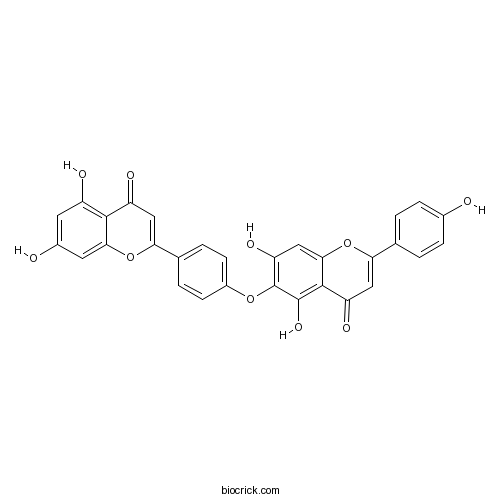Juniperus sabina
Juniperus sabina
1. The products in our compound library are selected from thousands of unique natural products; 2. It has the characteristics of diverse structure, diverse sources and wide coverage of activities; 3. Provide information on the activity of products from major journals, patents and research reports around the world, providing theoretical direction and research basis for further research and screening; 4. Free combination according to the type, source, target and disease of natural product; 5. The compound powder is placed in a covered tube and then discharged into a 10 x 10 cryostat; 6. Transport in ice pack or dry ice pack. Please store it at -20 °C as soon as possible after receiving the product, and use it as soon as possible after opening.
Natural products/compounds from Juniperus sabina
- Cat.No. Product Name CAS Number COA
-
BCN2989
Hinokiflavone19202-36-9
Instructions

-
BCN5957
Podophyllotoxin518-28-5
Instructions

Anti-arthritic Effects of Total Flavonoids from Juniperus sabina on Complete Freund's Adjuvant Induced Arthritis in Rats.[Pubmed: 27601846]
Twigs and leaves of Juniperus sabina L. have been traditionally used as the medicinal herb in China for the treatment of many ailments including rheumatoid arthritis (RA).
Anti-tumor effect of hot aqueous extracts from Sonchus oleraceus (L.) L. and Juniperus sabina L - Two traditional medicinal plants in China.[Pubmed: 27001625]
Sonchus oleraceus (L.) L (SO) and Juniperus sabina L (JS) are traditional medicinal plants in China. And the aqueous extracts of them have been used to treat tumor, inflammatory diseases, infection and so on in Chinese folk culture. However, the underlying mechanisms of their anti-tumor activities have not been illustrated yet.
Disentangling Facilitation Along the Life Cycle: Impacts of Plant-Plant Interactions at Vegetative and Reproductive Stages in a Mediterranean Forb.[Pubmed: 26904086]
Facilitation enables plants to improve their fitness in stressful environments. The overall impact of plant-plant interactions on the population dynamics of protégées is the net result of both positive and negative effects that may act simultaneously along the plant life cycle, and depends on the environmental context. This study evaluates the impact of the nurse plant Juniperus sabina on different stages of the life cycle of the forb Helleborus foetidus. Growth, number of leaves, flowers, carpels, and seeds per flower were compared for 240 individuals collected under nurse canopies and in open areas at two sites with contrasting stress levels. Spatial associations with nurse plants and age structures were also checked. A structural equation model was built to test the effect of facilitation on fecundity, accounting for sequential steps from flowering to seed production. The net impact of nurse plants depended on a combination of positive and negative effects on vegetative and reproductive variables. Although nurse plants caused a decrease in flower production at the low-stress site, their net impact there was neutral. In contrast, at the high-stress site the net outcome of plant-plant interactions was positive due to an increase in effective recruitment, plant density, number of viable carpels per flower, and fruit set under nurse canopies. The naturally lower rates of secondary growth and flower production at the high-stress site were compensated by the net positive impact of nurse plants here. Our results emphasize the need to evaluate entire processes and not only final outcomes when studying plant-plant interactions.
Facilitation promotes changes in leaf economics traits of a perennial forb.[Pubmed: 25903388]
Optimal allocation of resources is crucial to maximize plant success. Plants modify their economic strategies by adjusting functional traits in response to shifts in environmental conditions. Facilitation has been recognized as a major biotic filter of trait distribution in communities, although the effect of facilitation on intraspecific variability has been scarcely explored. We evaluated intraspecific shifts in leaf functional traits of a perennial forb (Helleborus foetidus) in relation to the presence of a nurse plant (Juniperus sabina) in two sites with contrasting abiotic stress levels. The effects of abiotic (site) and biotic (juniper presence, microsite) environments on specific leaf area (SLA), leaf area (LA), lamina/petiole length ratio (LPR), intrinsic water use efficiency (iWUE) and leaf nutrient content (N, P and N:P) per mass were evaluated. Alleviation of drought stress associated with nurse plant presence was reflected in SLA, LA, LPR and iWUE at the high-stress site. Individuals growing in open areas showed more resource-conservative traits, supporting the argument that this strategy is advantageous in environments that limit opportunities for rapid carbon gain. Leaf nutrients were unrelated to other traits. The large amount of intraspecific variation in leaf functional traits related to facilitative processes highlights the importance of facilitation as a major source of plant trait variation. Both positive and negative biotic interactions, as well as intraspecific trait variability, should be considered in mechanistic models of plant communities' functional responses to environmental changes.


